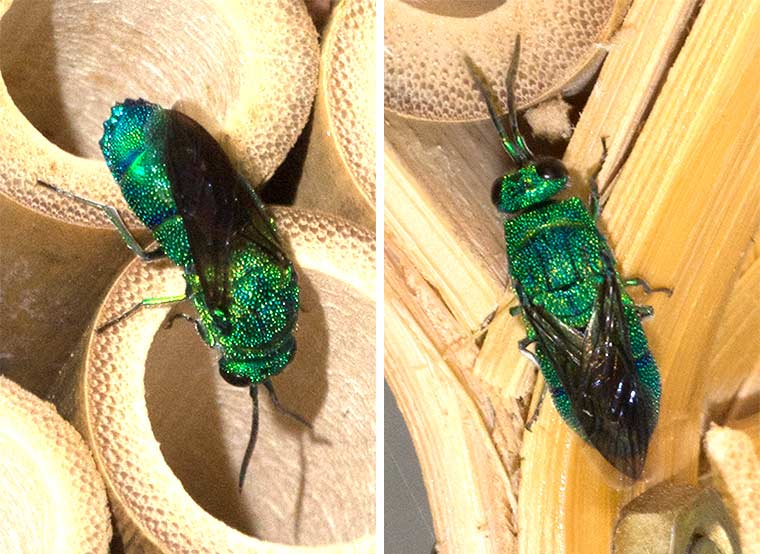I have illustrated some aspects of the life cycle of potter wasps nesting in our mason bee house in recent posts. These hard-working creatures carry mud back to the nest to construct cells, then they capture and paralyze caterpillars to stock the nest and provide nutrition for their developing larvae, When an opportunity presents itself, nature generally provides a creature to take advantage of the opportunity. Insects like potter wasps (and many other species of wasps, bees, and ants) have parasites that endeavor to take advantage of the hard work done by the host species.
The unlikely-looking creature pictured here is a species of cuckoo wasp. It waits for an opportunity to sneak in while the potter wasp is away. It then lays its own egg on the caterpillars provided by the potter wasp. The cuckoo wasp larvae is then able to eat the caterpillars which were provided for the potter wasp larvae. Usually the egg or larva of the potter wasp is destroyed during the hijacking of its nest by the ravenous cuckoo wasp larva. In some cases, the cuckoo wasp larva will allow the host larva to eat all the stored caterpillars and reach maturity before attacking and eating it.
The cuckoo wasp gets its name from a comparison with the birds called cuckoos, which lay their eggs in the nests of other species of birds and allow the other species to raise their young. I think the cuckoo wasp pictured here is a species of Chrysis, but identification to species is difficult. Cuckoo wasps also come in brilliant blues, reds or golds, and are also sometimes called jewel wasps, emerald wasps, golden wasps or ruby wasps
If the cuckoo wasp is discovered in the nest by the real owner, the cuckoo wasp can roll up into a tight defensive ball in which it is protected by its hard chitin exoskeleton. The host species is thus only able to expel the cuckoo wasp from the nest without being able to harm it.
The cuckoo wasp’s brilliant color is not caused by a pigment, but results from the refraction of light through the several layers of chitin in the exoskeleton. Many other colors in nature are the result of such an optical phenomenon. Examples include the brilliant colors of peacock or hummingbird feathers and the bright colors of many beetles and flies. No one has provided a convincing explanation of any function for the resultant brilliant colors in cuckoo wasps.

